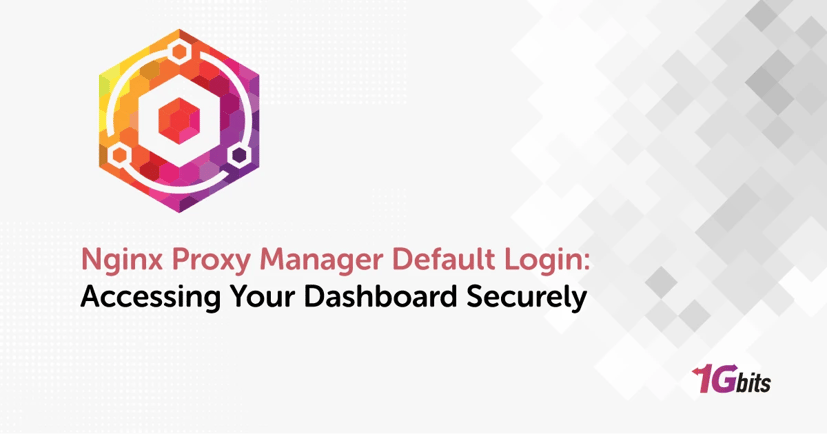Setting up NGINX Proxy Manager can save you hours of configuration time, but knowing how to access the NGINX Proxy Manager default login securely is essential. Whether you’re running it for a home server, a small business, or managing complex traffic rules, understanding the default credentials, common errors like NGINX Proxy Manager bad gateway, and how to reset your password will help you manage your proxies without hiccups.
In this comprehensive guide, you’ll learn:
-
What the NGINX Proxy Manager default login is.
-
How to troubleshoot issues like NGINX Proxy Manager default login not working.
-
The correct default port, credentials, and how to reset them.
-
How to integrate with Home Assistant.
-
Best practices to secure your admin panel.
-
Plus, answers to frequently asked questions!
What is the NGINX Proxy Manager?
NGINX Proxy Manager is an intuitive, web-based tool that acts as a simple frontend for managing your NGINX reverse proxy configurations. At its core, it helps you manage multiple proxy hosts, secure them with SSL certificates (including free Let’s Encrypt), and handle custom domains — all through an easy-to-use dashboard instead of editing complex NGINX configuration files manually.
This is a game-changer for self-hosters, small business servers, developers, or anyone who wants to expose local services to the internet safely. With NGINX Proxy Manager, you can:
✅ Add or remove proxy hosts with just a few clicks
✅ Issue and renew SSL certificates automatically
✅ Set up custom access lists and security headers
✅ Monitor which services are up and running through a clear UI
By default, the manager runs on port 81, which is the NGINX Proxy Manager default port, making the admin panel accessible via a simple URL like:
http://your-server-ip:81
📌 Tip: If you’re not yet familiar with how NGINX itself works, be sure to read our complete guide: What is NGINX. This explains how NGINX acts as a powerful web server and reverse proxy, and why tools like NGINX Proxy Manager make configuration so much easier.
Understanding the NGINX Proxy Manager Default Login
When you first deploy the Proxy Manager, you’re provided with a default login and password. This is handy because it lets you log in immediately without any additional setup. However, it also poses a security risk if you forget to change it.
Here’s what you should know about the NGINX default login and password:
|
Detail |
Default Value |
|
Admin Panel URL |
|
|
Default Email |
|
|
Default Password |
|
|
Default Port |
|
Many beginners forget that the NGINX Proxy Manager default port for accessing the admin panel is 81 — not the standard HTTP port 80. Failing to use the correct port is one of the most common reasons why the NGINX Proxy Manager default login is not working.
⚠️ Important: Always update your default credentials during the first login to prevent unauthorized access. Leaving the default changeme password can easily expose your server to attackers.
How to Find Your NGINX Proxy Manager Admin Panel URL
One of the first things you’ll need is the admin panel URL. By default, it’s:
http://<your-server-ip>:81
If you’re running NGINX Proxy Manager on a cloud VPS or self-hosted server, replace <your-server-ip> with your actual IP address or domain name.
Helpful checks:
-
Confirm your firewall allows traffic through port 81.
-
Ensure your Docker containers are running and properly mapped.
-
If you use a custom port, adjust the URL accordingly.
Keeping this URL handy will save you time troubleshooting “NGINX Proxy Manager default login not working” errors caused by simple typos or misconfigured ports.
First Login: Avoiding Bad Gateway Errors
It’s surprisingly common to see a 502 Bad Gateway error when you try to log in for the first time. The good news? This issue is usually simple to fix.
Why does this happen?
The error means that NGINX Proxy Manager can’t communicate with your upstream containers or services. This often happens when:
-
Docker containers didn’t start correctly.
-
Ports are mapped incorrectly.
-
Network settings in your docker-compose.yml file are wrong.
-
Your proxy host is pointing to an inactive backend service.
✅ Quick troubleshooting steps for “NGINX Proxy Manager default login bad gateway”:
-
Run docker ps to ensure your containers are up.
-
Check logs with docker-compose logs -f to identify errors.
-
Double-check your upstream services’ IPs and ports.
-
Verify your DNS records if you’re using a custom domain.
For an in-depth guide, read: How To Fix 502 Bad Gateway Error on NGINX.
NGINX Proxy Manager Reset Password
If you can’t remember your password or suspect your credentials are compromised, you’ll need to reset the NGINX Proxy Manager default password.
How to reset your password:
SSH into your server:
ssh user@your-server-ip
Open the Docker container shell:
docker exec -it <container_name> /bin/bash
Reset the admin credentials by updating the database or using the built-in commands provided by the container image.
Restart the container to apply changes:
docker restart <container_name>
🔐 Pro Tip: Make regular password resets part of your security hygiene — especially if multiple people manage your NGINX Proxy Manager admin panel.
Common Issues: NGINX Proxy Manager Default Login Not Working
Here’s what to check if you can’t log in with your default credentials:
-
✅ Verify the default email and password. Make sure you’re using admin@example.com and changeme on your first login.
-
✅ Check the admin panel URL. The default port is 81 — don’t forget it!
-
✅ Inspect your Docker containers. Use docker ps to confirm they’re running.
-
✅ Review firewall and security group settings. Ports 80, 443, and 81 must be open.
-
✅ Clear browser cache or use incognito mode. Sometimes, old sessions interfere with logins.
If you still face issues, search for the specific error (e.g., nginx proxy manager default login not working) to find community fixes and detailed walkthroughs.
Using NGINX Proxy Manager with Home Assistant
Home Assistant users love NGINX Proxy Manager because it makes exposing your smart home dashboard to the internet safer and easier.
Key steps to set up:
-
Create a new proxy host for your Home Assistant local IP.
-
Add a custom domain name, such as home.yourdomain.com.
-
Request a Let’s Encrypt SSL certificate through the dashboard.
-
Use access lists to limit who can log in from outside your network.
This approach ensures you’re not exposing your entire local network while allowing secure remote access — a must for any smart home setup.
📌 Many self-hosters search for nginx default login home assistant when setting this up for the first time.
Securing Your NGINX Proxy Manager Default Site
Every default site you expose through NGINX Proxy Manager needs proper security. Here’s how to keep things locked down:
✅ Update default credentials immediately.
✅ Use strong, unique passwords for each user.
✅ Enable two-factor authentication (2FA) if available.
✅ Keep your Docker images and NGINX Proxy Manager up to date.
✅ Back up your configuration regularly.
Following these steps protects your NGINX Proxy Manager default access and minimizes the chance of unauthorized logins.
Additional Tips for Managing NGINX Proxy Manager Credentials
🔑 Keep a secure record — Use a reputable password manager to store your credentials and admin panel URLs.
🔑 Audit access regularly — Know who has access and remove any outdated accounts.
🔑 Rotate credentials — If you ever suspect that your default or current credentials have been leaked, reset them immediately.
Final Thoughts: Take Control of Your Proxy Management
Understanding the NGINX Proxy Manager default login is the first step to securing your applications. Change the default credentials, secure your admin panel, and stay on top of common errors like the bad gateway issue.
Ready to learn more about optimizing NGINX? Check out our guide on What is NGINX and learn how to Fix 502 Bad Gateway Error on NGINX.
🚀 Ready to get started?
Most users run NGINX Proxy Manager on a reliable linux vps for maximum stability and security. If you don’t have one yet, grab your Linux VPS today and start managing your proxies with ease!







